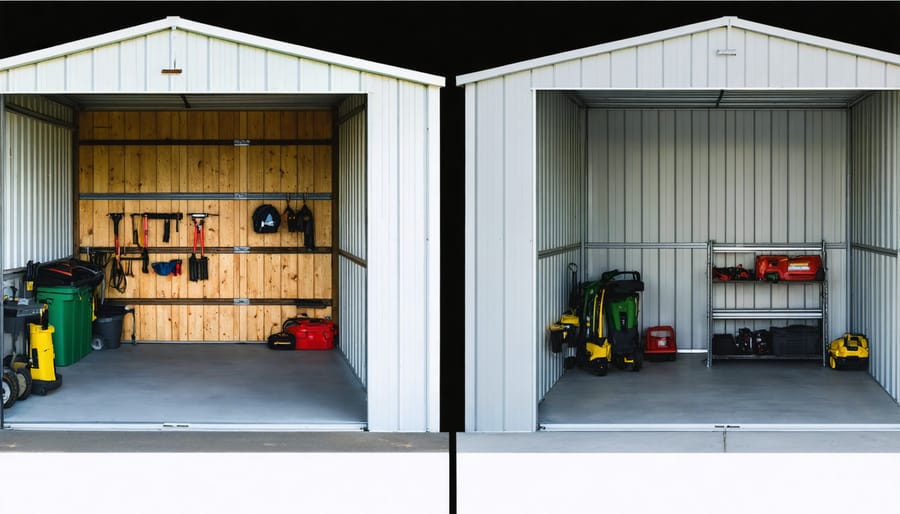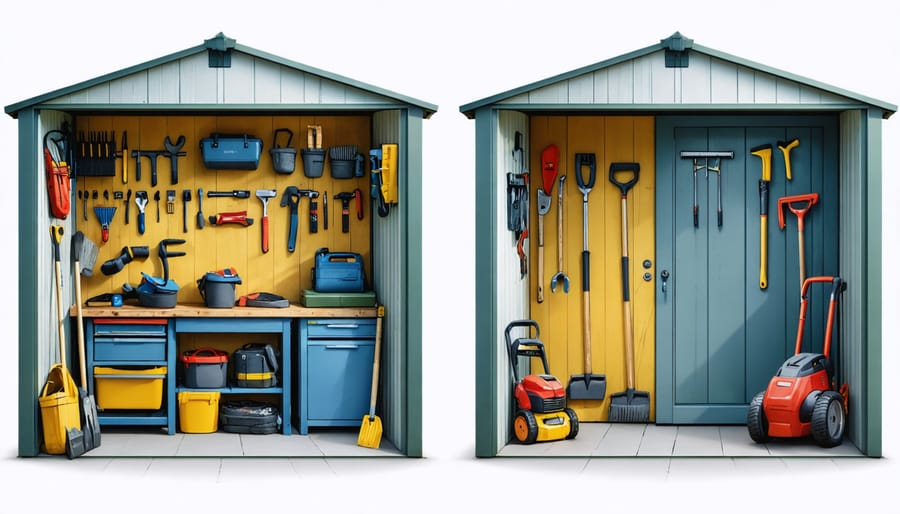Transform your storage space into a dynamic, year-round powerhouse that adapts seamlessly with each passing season. Four-season storage revolutionizes how homeowners manage their belongings, combining smart organization with strategic planning to maximize every square foot throughout spring, summer, fall, and winter. Gone are the days of seasonal chaos and cluttered corners – modern storage solutions now offer climate control, moisture protection, and modular systems that keep your items safe and accessible no matter the weather. Whether you’re storing delicate holiday decorations, temperature-sensitive garden equipment, or bulky winter gear, a well-planned four-season storage system ensures everything has its place and remains in pristine condition. This comprehensive guide will walk you through creating an efficient, weather-resistant storage solution that works as hard as you do, saving time, protecting valuables, and bringing peace of mind through every season.
Why Traditional Shed Storage Falls Short
While many homeowners strive to organize a shed effectively, traditional storage methods often fall short of meeting year-round needs. The most common challenge is the rigid, one-size-fits-all approach that doesn’t adapt to changing seasonal requirements. During spring and summer, gardening tools demand easy access, while winter calls for space to store patio furniture and holiday decorations.
Standard shelving units and basic hooks can’t adequately accommodate the shifting inventory of items throughout the year. This leads to cluttered floors, hard-to-reach corners, and the frustrating game of seasonal Tetris many homeowners play with their belongings. The lack of proper climate control in traditional sheds also poses risks to sensitive items, from rust formation on metal tools to mildew growth on fabric items.
Another significant shortcoming is poor space utilization. Fixed storage solutions don’t maximize vertical space or account for awkwardly shaped items like ladders and long-handled tools. This inefficiency often results in a chaotic mix of items that becomes increasingly difficult to manage as seasons change.
The absence of proper organization zones means seasonal items often get mixed together, making it challenging to locate specific tools or equipment when needed. This disorganization not only wastes time but can also lead to unnecessary duplicate purchases when items can’t be found.


Creating Flexible Storage Zones
Primary Access Areas
To effectively maximize your storage space throughout the year, create designated zones for items you use most frequently during each season. Near the entrance, maintain a primary access area that rotates with the seasons. In spring, keep gardening tools, seed trays, and pruning equipment within easy reach. During summer, position lawn care items, outdoor games, and pool supplies front and center. As autumn approaches, shift leaf blowers, rakes, and winter prep tools to this prime spot. For winter, ensure snow removal equipment, ice melt, and cold-weather gear are readily accessible.
Use clearly labeled bins or shelving units for quick seasonal transitions. Consider installing hooks or pegboards near the entrance for hanging frequently used tools. A rolling cart or portable caddy can help you quickly swap out seasonal items without reorganizing your entire storage space. Remember to keep a small year-round section for tools and equipment you need regardless of season, such as basic hand tools and safety gear.
Seasonal Rotation Spaces
Creating dedicated zones for seasonal items makes rotating your storage effortless throughout the year. Start by dividing your storage space into clearly marked sections: summer, fall, winter, and spring. Use sturdy shelving units along the walls, with each season occupying its own designated area.
Label everything clearly and consider using color-coding for quick identification – blue for winter items, yellow for summer gear, orange for fall decorations, and green for spring gardening tools. Installing adjustable shelving allows you to modify space allocation as needed, since winter equipment often requires more room than summer items.
Place frequently rotated items near the entrance for easy access. For example, position holiday decorations and seasonal sporting equipment where you can reach them without moving other items. Use clear storage bins to easily identify contents and stack them efficiently. Keep a seasonal inventory list posted near each zone to track what goes where and when it needs to be rotated.
Remember to position currently-needed items at eye level, while storing off-season equipment on higher or lower shelves. This simple organization system saves time and reduces the frustration of searching through cluttered spaces when seasons change.

Smart Storage Solutions for Each Season
Spring Storage Transitions
As winter thaws into spring, it’s time to reorganize your storage space for the warmer months ahead. Start by thoroughly cleaning and drying your winter equipment before storing it away. Snow blowers, snow shovels, and ice melt spreaders should be cleaned, maintained, and stored in the back or upper shelves of your storage area, as you won’t need them for several months.
Now’s the perfect time to bring your garden tools to the forefront. Create an easily accessible zone for items like rakes, trowels, and pruning shears. Consider installing a pegboard or tool rack on your wall to keep everything visible and within reach. Don’t forget to check these tools for rust or damage and give them a quick maintenance check before the gardening season begins.
Spring is also ideal for organizing your seed collection, plant containers, and gardening supplies. Use clear, weatherproof containers to protect seeds from moisture, and arrange pots by size for easy access. Remember to keep frequently used items at eye level and create designated spaces for new seasonal items like fertilizers and garden hoses.
Summer Organization
Summer brings outdoor living to the forefront, making efficient storage organization crucial for both accessibility and enjoyment. Start by creating designated zones for frequently used items like gardening tools, outdoor furniture cushions, and recreational equipment. Install wall-mounted hooks and tool organizers to keep garden implements off the floor while maintaining easy reach.
Consider adding weather-resistant storage bins for pool supplies, outdoor games, and BBQ accessories. Label everything clearly to maintain order throughout the busy season. Maximize vertical space with adjustable shelving units, perfect for storing lighter items like watering cans and plant pots.
Keep lawn care equipment like mowers and trimmers near the entrance for quick access during regular maintenance. Create a small workstation for potting plants or making minor repairs to outdoor furniture. Don’t forget to allocate space for summer-specific items like beach chairs and coolers.
To prevent clutter, implement a rotation system where less-used items move to higher shelves or back corners. This keeps your frequently accessed summer essentials front and center while maintaining an organized, functional space throughout the season.
Fall Preparation
As temperatures drop, it’s time to transition your storage space for the colder months ahead. Start by thoroughly cleaning and storing your summer items like garden tools, lawn furniture, and pool equipment. Before storing, ensure everything is completely dry to prevent rust and mildew. Consider using moisture-absorbing products in your storage area to maintain optimal conditions.
Create designated zones for winter equipment you’ll need easy access to, such as snow shovels, ice melt, and winter sports gear. Use vertical space efficiently by installing wall-mounted racks or pegboards for these items. Don’t forget to protect temperature-sensitive items like paint, electronics, or chemicals by moving them to climate-controlled areas if necessary.
This is also the perfect time to organize holiday decorations and winter clothing. Clear, labeled bins stacked neatly will make finding items easier when you need them. Remember to keep frequently used winter items at eye level or in easily accessible locations. Take inventory of summer items as you store them, noting any repairs or replacements needed for next season.
Winter Storage Strategies
Winter brings unique storage challenges, but with thoughtful organization, you can keep your seasonal items secure while maintaining easy access to cold-weather essentials. Start by creating designated zones for frequently used winter items like snow shovels, ice melt, and winter sports equipment near the entrance. Use weatherproof bins labeled clearly for quick identification, and consider installing hooks or wall-mounted racks to keep these items off the floor.
For summer items going into hibernation, ensure they’re properly cleaned and dried before storage. Garden tools should be thoroughly cleaned and oiled to protect your tools from rust during the damp winter months. Stack patio furniture efficiently, using furniture covers for additional protection, and store cushions in airtight containers to prevent moisture damage.
Consider installing a small dehumidifier or moisture-absorbing products to maintain optimal conditions. Place temperature-sensitive items on elevated surfaces or shelves to protect against potential ground frost. Remember to keep pathways clear for safe access during snowy conditions, and regularly check stored items throughout the season to catch any issues early.
Maintenance Tips for Year-Round Success
Regular maintenance is key to keeping your four-season storage system working smoothly throughout the year. Start by inspecting your storage units quarterly for signs of wear, loose hardware, or damage. Tighten any loose screws, hinges, or brackets immediately to prevent further issues.
Keep your storage space clean by dusting shelves and wiping down surfaces monthly. This prevents dirt buildup and makes it easier to spot potential problems early. Check weather stripping and seals around doors and windows seasonally, replacing them as needed to maintain climate control.
Lubricate moving parts like door hinges and tracks twice yearly to ensure smooth operation. Pay special attention to ventilation systems, keeping vents clear of debris and checking that fans or dehumidifiers are working properly.
Test your lighting system regularly and replace bulbs as needed. Consider applying a fresh coat of protective sealant to wooden components annually to prevent moisture damage. Finally, maintain clear pathways by regularly reorganizing items and removing any clutter that could obstruct access to your stored belongings.
Remember, consistent maintenance not only extends the life of your storage system but also protects your valuable items year-round.
Implementing a four-season storage system transforms your shed from a simple storage space into a dynamic, year-round organizational hub. By adapting your storage layout to accommodate seasonal transitions, you’ll save time, protect your belongings, and maximize every square foot of space. This systematic approach ensures easy access to items when you need them while keeping rarely-used equipment safely stored away. The benefits extend beyond organization – you’ll extend the life of your tools and equipment through proper storage, reduce clutter in your home, and eliminate the frustration of searching for misplaced items. With clearly defined zones and a flexible storage plan, you’ll be prepared for every season’s unique demands while maintaining an organized, efficient space that serves your needs year after year.





Leave a Reply